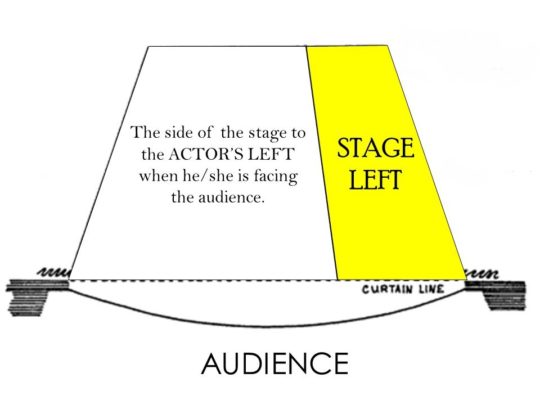How a Strange Fact About Eyeballs Could Change Your Whole Marketing Plan
What public speakers accidentally know about neuroanatomy
 As an author, I often speak at conferences and events. I take the craft of public speaking very seriously and have studied the best of the best.
As an author, I often speak at conferences and events. I take the craft of public speaking very seriously and have studied the best of the best.
The really good ones know exactly how to take their audiences on an emotional journey by using stories, humor, vocal inflection, music, visual aids, and every other tool at their disposal. (More about these in a free gift I have for you at the end of this article.)
Including a strange fact about the biology of eyeballs and brains.
Speakers have a saying…
Make ’em laugh from the left and cry from the right.
In other words, when delivering a joke, physically move your body to the left side of the stage. But if you’re telling an emotionally stirring story, then stand on the right side of the stage. When I try it, it really seems to increase the impact of my presentations.
But WHY???
Is it just about consistency? Spatial anchoring? Over time, the audience is just conditioned to expect emotion on stage right and humor on stage left? Maybe that expectation quickly becomes a self-fulfilling prophesy?
Maybe. But then why does it also work the first time I do it? The audience hasn’t had any time to be conditioned yet.
Or what about this next theory? In America, we read from left to right. So, maybe tracking the speaker’s body movement from stage right to stage left feels “normal” and pleasant, making laughter easier. However, going from stage left to stage right feels “backwards” and unpleasant, making the tears flow more easily.
Again, maybe. But then why does it also work in countries where the language is read from right to left? Clearly, something else is going on here.
What public speakers accidentally know about neuroanatomy could change your #marketing: Share on XNeuroscience gives us an answer.
While researching my book, The Four Levels of Influencing People, I took several online neuroscience classes. One of them explained the reason that this technique works on audiences without any prior conditioning and regardless of language. The concept is universal and its applications go far beyond just public speaking. It’s a fact that could significantly affect your web site and marketing pieces.
It’s because of some strange anatomy going on behind the human eye. I’ll spare you most of the unnecessary medical terminology and details, but the basic process is quite fascinating and highly relevant.
It is a well-known fact that the left side of the brain controls the right side of the body and vice-versa. But the eyes are different. Input from the right eye isn’t exclusively processed by the left brain hemisphere. Instead, input from the right visual field is processed by the left brain hemisphere, regardless of which eye is receiving the input.
This allows you to focus BOTH of your eyes on something to your right, and reach out and grab it with your right hand – all using your left hemisphere. It’s highly efficient.
Try this experiment:
- Point your nose directly at this screen.
- While facing forward, turn your eyes to the RIGHT and look at an object.
- Reach out with your LEFT hand to pick it up.
- Switch sides and repeat.
It’s slightly more difficult to use the opposite hand accurately, isn’t it?
Here’s a diagram of how the eyes and brain work together to accomplish this:

The back of each eye is split into two sides (they’re aptly called the nasal and temporal sides after the nearby nose and temple, respectively). So anyone who called you “four-eyes” in grade school was sort of accurate – but it had nothing to do with your glasses. They were a “four-eyes” just as much as you were.
Any light rays that strike the nasal side of the retina travels down the optic nerve, cross at the Optic Chiasm, and head over to the other side of the brain for processing. However, any light rays that strike the temporal side remain on the same side of the brain.
As an example, follow the pink pathways in the diagram above. You can see that input from the right visual field will be processed by the left half of the brain – no matter which eye is receiving the input.
So, when a public speaker “Makes ’em laugh from the left,” (that’s stage left, see below) s/he is stimulating the audience member’s left hemispheres. The left hemisphere is also the dominant hemisphere for most types of humor. A pun is a play on words. Surprise and hyperbole are breaches of logic. Language and logic are primarily left brain functions.

So stage left is in the audience’s right visual field and processed by their left brain hemisphere. Which is perfect for things that make you laugh.
Got it? (If not, here’s a helpful video demonstration: http://www.khanacademy.org/science/health-and-medicine/nervous-system-and-sensory-infor/sight-2014-03-27T18:45:34.237Z/v/visual-field-processing)
Emotions on the other hand, are processed (not exclusively, but primarily) by the right hemisphere of the brain. Which is why speaker coaches teach, “Make ’em cry from the right.”
If you want your marketing messages to be delivered effectively through any kind of visual media, then put appeals to logic in their right visual field and appeals to emotion in their left. Web sites, Facebook ads, television commercials, live sales pitches, Powerpoint presentations, magazine ads, billboards, and more all have an opportunity to be designed more effectively with this fact of human biology in mind.
Marketers: Neuroscience says you should put emotional appeals in left visual field, logical in right. Share on X
Did you find this useful? For 61 more science-based sales tips, download The Influence Cheat Sheet for FREE here: http://moreinfluential.com/cheatsheet
